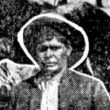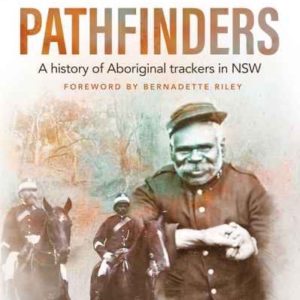Loading map...

Jack Redtank, the son of Ngiyampaa speakers Jimmy Keewong and Kitty Narrangie, was recognised as being one of the best trackers in NSW in the late 19th and early 20th centuries. His talents were brought to the attention of the authorities by David Harris, a European bushman who lived with Emily Keewong, Jack’s sister. Jack’s first job aged 16 was at W-Tree Station in 1897 when he found a girl who had been lost in the bush for six days.[ref]Barrier Miner 8 September 1897: 3; see also The Land 7 March 1952: 24 & Northern Star 29 September 1897: 6; W-Tree Station is located between Yallock and Red Tank Stations, approximately 10km north of Carowra Tank.[/ref] He won praise for his efforts and abilities:
“Senior Constable Capewell says that the tracking of this blackfellow was something marvellous. In places the ground was so hard that those forming the search party could not discern anything even when shown by the blackfellow what he was following. However, he was never once at fault, the proof coming on a soft place after travelling a mile or more without a trace to the others of the party, but the mere moving of a pebble or wisp of grass would not escape the keen eye of Red Tank Jack, who is a Yallock station “boy”. Each night the party camped on the track and started the search next morning.” [ref]Barrier Miner 8 September 1897: 3. [/ref]
It is clear from the article that Jack Redtank had a detailed knowledge of the landscape. He also worked further south in the Keewong district. Elizabeth Kennedy, a descendant of Jimmy Keewong, told Donaldson that some thought Jack Redtank had “magic eyes”. [ref]Kennedy and Donaldson 1986, transcription of field tapes, AIATSIS, 49-53 LA 9701-9707. [/ref]
From 16 February 1899 to the end of 1901 he was stationed at Parramatta, although he spent much of the latter part of 1900 pursuing Jimmy and Joe Governor. Sent to Wollar in the days after the massacre[ref]See Cumberland Argus and Fruitgrowers Advocate 28 July 1900: 1; also Mudgee Guardian and North-Western Representative 30 July 1900: 4.[/ref], he was still pursuing the fugitives in early October. At one point he was reported missing near Wollar and it was thought he may have been captured by the Governors.[ref]Mudgee Guardian and North-Western Representative 24 September 1900.[/ref] This proved to be untrue and his efforts later received praise from some quarters of the press. A correspondent for the Sydney Evening News was told by Mr Lawrie of Rawdon Vale, whose son was also pursuing the brothers, that Jack Redtank was doing “good work” and that when conditions were favourable, he followed the “trail so fast that the horsemen in the party (had) to go as a jog trot to keep up with him”. [ref]Evening News 2 October 1900: 3. [\ref]
Redtank married an Aboriginal woman called Maggie at Keewong Station near Ivanhoe. Their only known child was Alice who was born in 1900. Further details of Jack’s life are unknown, but Maggie Redtank died at Mossgiel on 9 April 1928 from heart failure. [ref]Death Certificate of Maggie Redtank 1928/07161.[/ref]

 This website explores the history of Aboriginal trackers in NSW from 1862 when the current NSW Police Force was established through to 1973 when the last tracker, Norman Walford, retired. You can read about the lives of individual trackers and some of the incredible tracking feats they...
This website explores the history of Aboriginal trackers in NSW from 1862 when the current NSW Police Force was established through to 1973 when the last tracker, Norman Walford, retired. You can read about the lives of individual trackers and some of the incredible tracking feats they...

There were over 200 NSW police stations that employed Aboriginal trackers between 1862 and 1973. Many were concentrated in the central-west and north-west of the state, the agricultural and pastoral heartland of NSW. This is because one of the main jobs of trackers was to pursue sheep, cattle and horse thieves. Trackers sometimes lived in small huts out the back...
Learn More ►
Pathfinders book Pathfinders, A history of Aboriginal trackers in NSW, written by Dr Michael Bennett and published by NewSouth, is now available from all good bookstores. Click on the link below to order your copy. https://www.abbeys.com.au/book/pathfinders-a-history-of-aboriginal-trackers-in-nsw.do Early History Since the beginning of the colony, government agencies, explorers, surveyors and members of the general public called upon the tracking...
Learn More ►